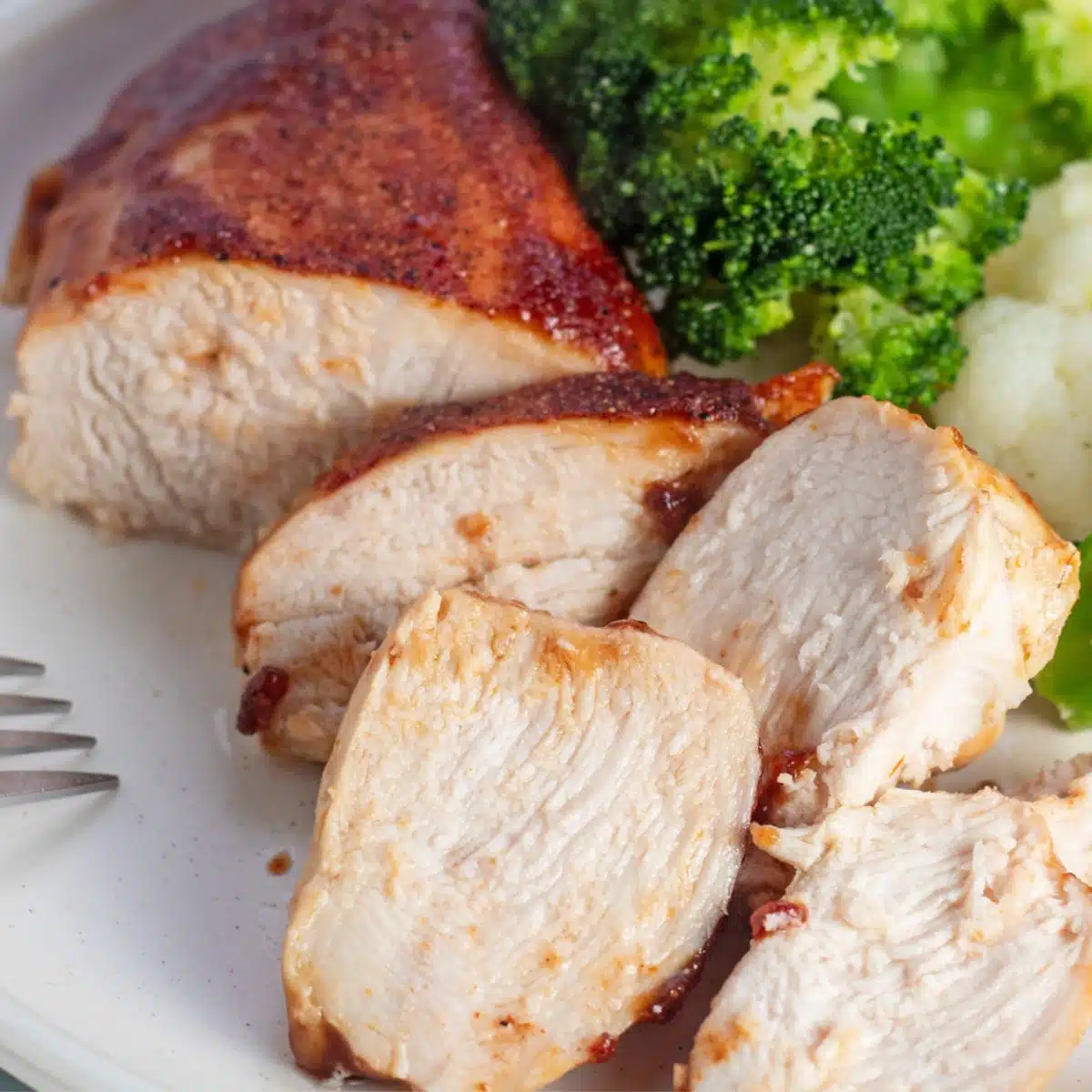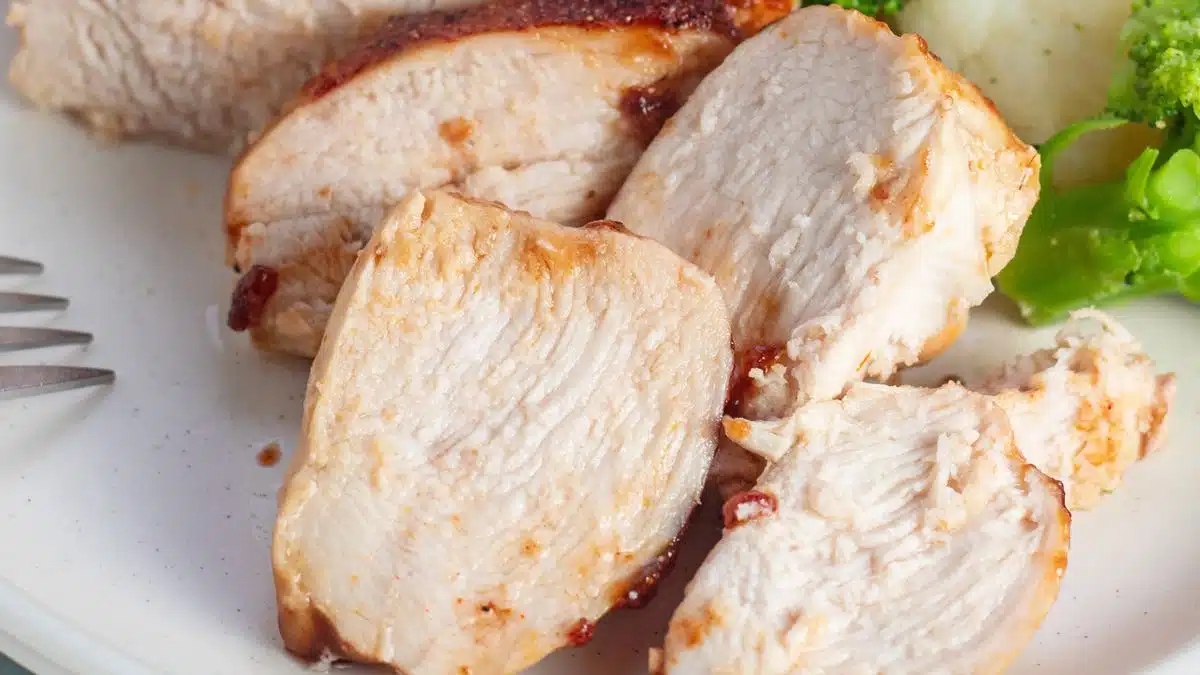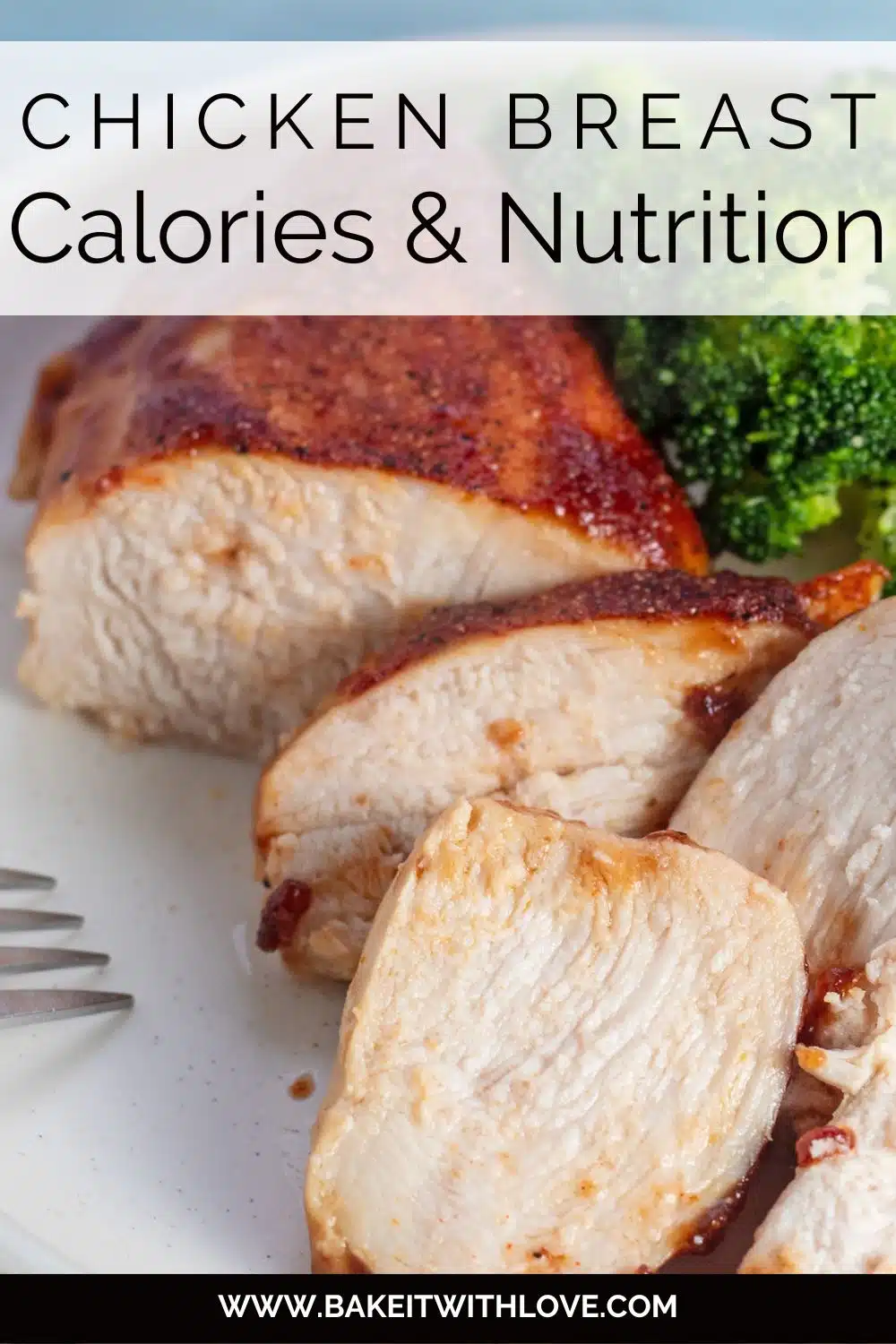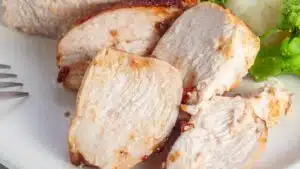Understanding chicken breast calories and nutrition is a great way to ensure that you're eating what is best for you! This simple and thorough guide will show you everything there is to know about the nutritional makeup of chicken breasts, all the way from calories to carbohydrates! Keep on reading to learn all about how chicken breasts can be a part of your healthy diet!
Guide To Chicken Breast Nutrition
Chicken is probably the most popular protein of choice across the country. Especially chicken breasts. As the leanest part of the chicken, chicken breasts are a favorite for people who are looking to cut calories.
However, it is not just health-focused people who enjoy chicken breasts. As one of the most common animal proteins available, chicken breast is easy and inexpensive to find at the grocery store. Moreover, it is extremely versatile.

Jump to:
- Guide To Chicken Breast Nutrition
- Calories in Chicken Breast
- Calories in 1 Ounce of Chicken Breast
- Calories in Grams of Chicken Breast
- Calories in a Cup of Chicken
- Additional Calories in Chicken Breast
- Chicken Breast with Skin
- Cooking Fat
- Seasonings
- Marinades
- Nutritional Value of a Chicken Breast
- Cooking Chicken Breasts
- 🐔 Best Chicken Breast Recipes
- 📖 Recipe Card
- 💬 Comments & Reviews
Although this is a popular food choice, a lot of cooks do not know the exact details about its nutritional value. If you are ready to learn though, keep reading to learn all you need to know about chicken breast calories and nutrition.
Make sure to check out all of my delicious chicken breast recipes and chicken marinades!
Calories in Chicken Breast
Calories are the first place that most people look to determine the nutritional value of a food. So, let us first look at the calories in a chicken breast.
Most cooks consider a standard serving size of chicken breast to be 3.5 ounces. This is about 100 grams of chicken.
According to the US Department of Agriculture, this standard serving size chicken breast has approximately 193 calories. I say “approximately” because while this is the most accurate source of information, it can vary slightly.
If a cut of chicken breast is extra lean it may be closer to 187 calories. However, one that is a bit fattier may be around 200 calories. On average though, you can be confident that a 3.5-ounce chicken breast is just under 200 calories.
Calories in 1 Ounce of Chicken Breast
Although 3.5 ounces is considered the standard, this is not the only serving size. In fact, many people may look at a 3.5-ounce measurement and think it seems small.
Therefore, knowing how many calories are in one ounce can help you quickly approximate how many calories are in any size of chicken breast.
A chicken breast has about 55 calories per ounce.
If you do not have a scale to measure, then you can use a simple trick using the palm of your hand. A chicken breast that measures the size of an average adult’s palm is between 3.5 to 4 ounces.
Using this simple trick, you can guess how many calories are in any chicken breast. Whether you are eating at a restaurant or at home.
If the serving size is on the smaller side, you can subtract 27-55 calories (depending on if it is a half-ounce to an ounce smaller). If it is larger, then simply add 55 calories for every additional ounce you think there is.
Calories in Grams of Chicken Breast
In the United States, meat is commonly measured in ounces. However, in other areas of the world chicken is measured in grams. Therefore, you may need to know how many calories are in a chicken breast weighed in grams.
Use the measurements below to determine how many calories are in two common sizes of chicken breast weighed by grams.
- 100 Grams of Chicken Breast: 160 calories
- 120 Grams of Chicken Breast: 193 calories
100 grams of chicken is about the same as 3.5 ounces. This is the size of a small chicken breast.
Calories in a Cup of Chicken
Not everyone has a food scale to weigh chicken at home. However, most of us have a measuring cup at home.
A measuring cup generally holds more than a standard size of 3.5 ounces. Therefore, you will notice there are more calories in 1 cup of chicken breast.
- 1 cup of chopped chicken breast = approximately 217 calories.
Measuring chicken in a measuring cup will vary depending on the size of the chicken pieces and how much you pack into the cup. You can guess that one cup will always be a little over 200 calories though.

Additional Calories in Chicken Breast
Based on the calories it is easy to see why chicken breast is such a popular choice for lean protein. It is important to keep in mind that this is for boneless skinless chicken breasts.
Boneless skinless chicken breasts are typically what is being referenced when ordering chicken in a restaurant or making a recipe at home. However, not all chicken breasts are boneless or skinless.
Chicken Breast with Skin
Chicken is one of the few animal proteins that we eat with the skin. While it is not as common to eat chicken breast like this, compared to chicken wings or legs, it is not unlikely. Especially if you are eating fried chicken.
The addition of the skin adds calories and fat to the chicken breast. Moreover, if it is fried there is the addition of calories and fat from the oil.
Measuring the number of calories in a chicken breast with skin or fried chicken breast is a bit trickier. It will depend on how much skin is left on and how much you eat. Moreover, if it is fried it will vary depending on the exact preparation.
Here are some approximate measurements of calories to help you get an idea.
- Medium chicken breast with skin (120 grams) = about 250 calories
- Medium fried chicken breast with skin (120 grams) = about 312 calories
Cooking Fat
Even if you are not eating the skin or frying the chicken other methods of cooking can also add calories. If you cook the chicken breast in any type of oil or butter, then be mindful of how many calories are in each serving of the oil or butter that you add.
To keep the calories low, consider low-fat cooking options such as grilling, baking, or poaching. In addition, you can make delicious chicken breast recipes in the air fryer.
Seasonings
Beyond how you cook your chicken breast, the seasonings you use can also impact how many calories there are. If your focus is to keep the calorie count low, then choose dry seasonings.
There are several tasty seasonings like Creole seasoning, Italian Seasoning, and Poultry seasoning that can add flavor without calories. Salt and pepper are also always safe options.
Marinades
In addition to dry seasonings, a liquid marinade or sauce is a tasty way to add flavor to chicken breasts. While many of these are low-fat, they do have some calories.
When choosing a sauce or marinade make sure to read the label carefully. Many store-bought sauces have sugar in them. Especially popular chicken marinades such as teriyaki sauce or BBQ sauce.
While these will add calories and carbohydrates, they will typically not add fat. Therefore, you can still enjoy a lean dish with only a few added calories.
Nutritional Value of a Chicken Breast
While calories are helpful for understanding the basic nutritional value of food, they are not the only components. One of the main reasons people choose chicken breasts is because of the low-calorie count and the high protein content.
You can see the protein content and other macronutrients in different serving sizes of chicken breasts below.
3.5-ounce (100 grams) Chicken Breast
- 32 grams of protein
- 3 grams of fat
- 0 grams of carbohydrates
120 grams of Chicken Breast
- 38 grams of protein
- 3.6 grams of fat
- 0 grams of carbohydrates
1 cup of Chicken Breast
- 43 grams of protein
- 4 grams of fat
- 0 grams of carbohydrates
Cooking Chicken Breasts
Naturally low in calories and fat, and with zero carbohydrates, chicken breast is an excellent healthy choice for lean protein. If you are cooking it without the skin and using low-calorie cooking methods.
My baked BBQ chicken breast recipe is an excellent way to keep the fat grams low without having too many additional calories. On the other hand, if you are not worried about fat but want to keep carbs low then try one of my creamy chicken dishes, like my million dollar baked chicken.
And as I mentioned earlier, some simple dry seasonings and baking the chicken will keep the calories in the chicken breast as close to the original calories as possible.
Whatever cooking method you choose or seasonings you add, start with the information above. This will help you determine how many calories are in the chicken breast you are cooking. From there, feel to free to add any additional calories you would like!
I hope that this information was super helpful to you! Leave a comment down below and let me know your favorite way to enjoy some chicken breast!
>>>>See all of my recipes here<<<<

🐔 Best Chicken Breast Recipes
- Oven Roasted Bone-In Chicken Breast - This delicious bone-in chicken breast is roasted in the oven for an easy and healthy meal!
- Maple Bacon Dijon Chicken Breasts - Perfectly cooked chicken is coated with a decadent and creamy sauce!
- Ritz Chicken - Chicken is coated with crushed Ritz crackers and drizzled with butter!
- SweetFire Chicken Breasts - This tangy and sweet chicken dish is even better than the kind from Panda Express!
- String Bean Chicken Breasts - An all-in-one meal that includes both chicken and string beans!
- Stuffing Stuffed Chicken Breasts - Loading your chicken breasts with stuffing is a great way to take your meal to the next level!
Do you love a recipe you tried? Please leave a 5-star 🌟rating in the recipe card below and/or a review in the comments section further down the page.
Stay in touch with me through social media @ Pinterest, Facebook, Instagram, or Twitter! Subscribe to the newsletter today (no spam, I promise)! Don't forget to tag me when you try one of my recipes!
📖 Recipe Card
Chicken Breast Calories & Nutrition: Air Fryer Chicken Breast (+More Tasty Recipes!)
Ingredients
- 1 lb chicken breasts (approximately 2 boneless, skinless chicken breasts)
- 1 teaspoon paprika
- ½ teaspoon each, salt & pepper (to taste
- ½ teaspoon garlic powder
- ½ teaspoon onion powder
(Note: 2x or 3x only changes the ingredient list)
Instructions
- Prepare the chicken breasts by placing them on a cutting board and wrapping them with a large piece of plastic wrap. Use a meat mallet or a rolling bin to pound the chicken breasts until they are even in thickness.
- Place the chicken breasts on a plate and season them with salt, pepper, garlic powder, onion powder, and paprika as a dry brine. Place the plate into your refrigerator uncovered for at least 40 minutes or up to 24 hours.
- When you are ready to cook, let the chicken breasts set at room temperature for 15 minutes to take the chill off. Place them smooth side down in the air fryer basket and cook at 380°F (195°C) for 6 minutes. Use kitchen tongs to flip over and cook for another 6-8 minutes or until the internal temperature reaches 165°F (75°C).
- Remove the chicken breasts from the air fryer and transfer them to a plate. Cover with a square of aluminum foil and rest for 5 to 10 minutes before serving.
Notes
- If you decide that you would like to skip the dry brine (though I highly recommend it), you can coat the chicken breasts with 1 tablespoon of olive oil in a large mixing bowl and season evenly on both sides. Dry brining will season the breasts all of the way through which results in the juiciest chicken and best-tasting results.
- To ensure that the internal temperature reaches 165°F (75°C), I recommend using a meat thermometer if you have one. Check out my article on chicken internal temperatures for more information.
- You could also leave the chicken breasts in the air fryer basket to rest if you'd like, just be aware that there will be a lot of juices from the chicken. *Note that this continues cooking the chicken a lot more than the 5°F you would normally see in carryover cooking during resting any cooked meat.
- To store: Place any leftovers in an airtight container in the refrigerator for up to 4 days.
- To freeze: Wrap your leftover chicken with plastic wrap and place the chicken in a freezer-safe container or heavy-duty freezer storage bag. Thaw overnight in the refrigerator and enjoy within 3 months.
- To reheat: Use your microwave and heat the chicken until it is warmed to your liking. You can also return the chicken breasts to the air fryer to rewarm them too.



Comments
No Comments